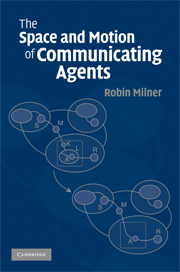12 - Background, development and related work
Published online by Cambridge University Press: 05 August 2012
Summary
In this chapter we place the bigraph model in the broader informatic context.
The bigraph model attempts to bridge two distinct cultures. On the one hand is the adolescent culture of ubiquitous computing; on the other hand is the more mature theory of concurrent processes. The first two sections of this chapter describe the two cultures in enough detail to show how the bigraph model fits into each of them, and how together they demand the existence of some such model. In the third section I describe how bigraphs evolved as a generic model of processes. Finally I describe ongoing work to create software tools that will bring bigraphs to life as a language for programming and simulation, thus admitting experiments that will help to assess the scientific value of this model.
Background in ubiquitous computing Let us first look at the vision of ubiquitous computing. Mark Weiser [79] is generally credited with forming this vision and inspiring research that will bring it to reality; I quoted him briefly in the Prologue. The vision represents one of the most ambitious aspirations of computer science, and has been adopted as a Grand Challenge by the UK Computing Research Committee (UKCRC). The title of its manifesto [1], ‘Ubiquitous computing: experience, design and science’, reflects the insight that to realise the vision demands collaboration among three distinct research communities: those concerned with the human–computer interface and human behaviour, those concerned with engineering principles and design patterns for large systems, and those concerned with theoretical models and the languages that bring them to life. These three themes cannot be addressed in isolation.
- Type
- Chapter
- Information
- The Space and Motion of Communicating Agents , pp. 139 - 145Publisher: Cambridge University PressPrint publication year: 2009

